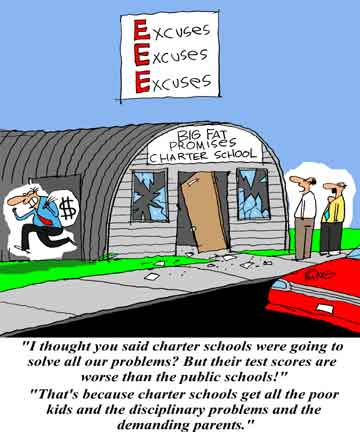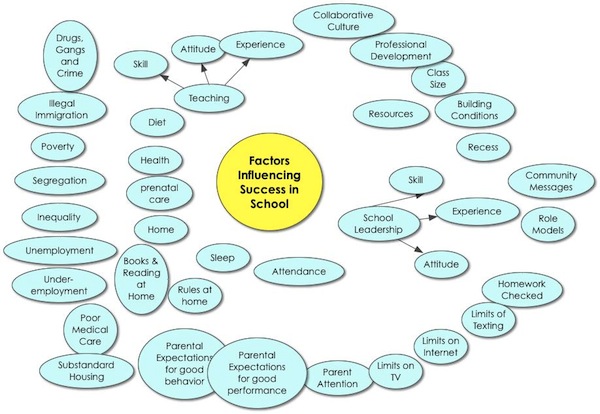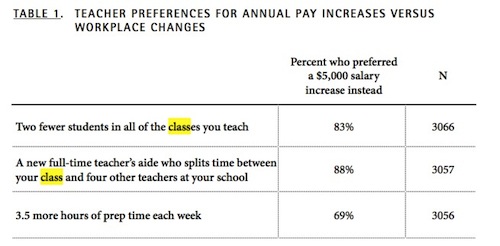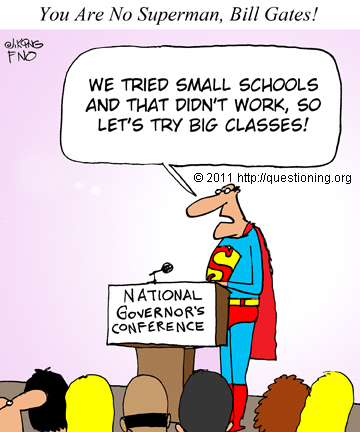Ravitch provides evidence that most parents with students in public schools are happy with the schools their children attend:
- The annual Gallup poll about education shows that Americans are overwhelmingly dissatisfied with the quality of the nation’s schools, but 77 percent of public school parents award their own child’s public school a grade of A or B, the highest level of approval since the question was first asked in 1985.
Her review goes on to identify factual distortions and inaccuracies in the film that are quite serious:
- Some fact-checking is in order, and the place to start is with the film’s quiet acknowledgment that only one in five charter schools is able to get the “amazing results” that it celebrates. Nothing more is said about this astonishing statistic. It is drawn from a national study of charter schools by Stanford economist Margaret Raymond (the wife of Hanushek). Known as the CREDO study, it evaluated student progress on math tests in half the nation’s five thousand charter schools and concluded that 17 percent were superior to a matched traditional public school; 37 percent were worse than the public school; and the remaining 46 percent had academic gains no different from that of a similar public school.

The above cartoon first appeared when a government report showed that charter schools scored poorly on the 2003 NAEP tests in comparison with their public school counterparts. http://nochildleft.com/cartoon25.html
1. The Blame Game
It is unfortunate that Guggenheim devoted little attention to the challenge of teaching disadvantaged children in disadvantaged neighborhoods and schools. His movie follows five children and families who hope to flee their neighborhood schools for a charter school, but he never takes the time to understand or portray the daily work of teachers who must try to convert poor readers into good readers in any school. If he had taken that time, he might learn why most charter schools do no better on average than their public school counterparts according to many studies.
Guggenheim's only success stories are charters but even though he admits only one in five charters is successful, he does not show the failures in his film and he shows no public school success stories. This is typical of his over-simplification of a complex challenge. The system is broken, he claims. He also accepts the success of programs like KIPP without scrutiny, never mentioning issues raised by the authors of The Charter School Dust-Up:
- Some observers, such as the authors of The Charter School Dust-Up, say that KIPP's admission process self-screens for students who are both motivated and compliant, from similarly motivated and compliant—and supportive—families. Parents must commit to a required level of involvement, which rules out badly dysfunctional families.
- In addition, some KIPP schools show high attrition, especially for those students entering the schools with the lowest test scores. A 2008 study by SRI International found that although KIPP fifth-grade students who enter with below-average scores significantly outperform peers in public schools by the end of year one, "... 60 percent of students who entered fifth grade at four Bay Area KIPP schools in 2003-04 left before completing eighth grade.
-
He divides the educational world into good guys and bad guys and claims that the "system" makes it impossible for public schools to succeed, often relying on the biased testimony of public school critics to speak for him. He does not give any impressive public school advocates a chance to counter these assaults. It is an unfair fight as he parades the AFT Union President across his screen a number of times with carefully selected damaging statements. After releasing the film he has claimed that "I don't think charters are the answer." but it is impossible to see his film and draw any other conclusion about his message.
Education Week reported on the recent success of a public school district in California — Sanger — that made significant gains in performance across the board using RTI - the response-to-intervention framework. "Calif. District Uses RTI to Boost Achievement for All"
- California measures its schools on an “academic performance index,” an annual measure of test-score performance that starts at 200 and tops out at 1,000. The target is 800 points or more. In 2004, Sanger’s API was 599 points. In 2010, it was 805.
RTI may not be the solution for all schools, but the Sanger story is worthy of a movie to show how public schools with large populations of disadvantaged students can rally to serve them well. How could Guggenheim overlook these success stories? He sets up a false dichotomy throughout the film — charters are good and public schools are bad.
While teachers in public schools might be a convenient target for a piece of propaganda, Guggenheim studiously avoided a bundle of inconvenient truths that would have muddled his simplistic view and message. He ignored the success stories as he painted public schools with a broad brush. This is a typical strategy of propaganda films, along with manipulative appeals to emotion. Nuance is throttled.
Guggenheim never once shows poor readers stumbling through their lessons with the help of a skilled teacher of reading. He never shows excellent teachers in public schools struggling to turn non-learners into learners.
He does return to an earlier film he made about first year teachers in LA, but rather than showing them as success stories, he used them to deliver another attack on "the system." One of his "experts" who delivers negative messages throughout the film states that you ". . . have to remember that teachers are wonderful and unions are terrible."
Guggenheim fails to chronicle the resource issues facing teachers in disadvantaged schools. He does not point to the damage done by poverty, segregation and difficult social conditions. His film devotes attention to two somewhat successful charter school efforts (Harlem Academy and KIPP) — each of which has benefitted from some special conditions and ends up claiming (falsely) "Now that we know that it is possible to give every child a great education, what is our obligation to other people's children?"
Because these schools have done well with families and students from difficult neighborhoods, he dismisses those issues as challenges, but he does not note that one of his favorite programs KIPP has been criticized for issues regarding selection of mostly motivated students and a high level of attrition as mentioned above.
It is ironic that Guggenheim decided to produce this film as he drove past public schools in Washington, D.C. while he delivered his own children to attend the elite private school, Sidwell Friends — a school with very small classes and great resources that taxpayers would never support.
In many respects, his movie is like a drive-by shooting. Despite his protest to the contrary, his film vilifies public school teachers and schools in the aggregate without taking the time to understand them. He presents a cartoon-like caricature of public schools and teachers, devoting lots of time to what he calls "drop out factories" — schools where many children never graduate.
What he fails to explore are the reasons that some students do badly in school and why they tend to drop out in higher percentages from some schools than others. He simply places the blame on teachers and the system. He shows no understanding of teaching and learning and no appreciation for the difficulty of teaching difficult children. Waiting for Superman shows no signs that he learned anything from his movie that documented the first teaching year of five teachers in the LA district. He is more interested in attacking teacher unions and tenure — a major focus of the movie.
- "For public school teachers, 'Tenure has become automatic' (A lie.)
"You are there for life even if you are a lousy teacher. (Another lie.)" His own movie interview an opponent of tenure who reports the data on the firing of tenured teachers in Illinois.
2. The Real Challenge
Anyone who has taught in private or public school will encounter children who are difficult to teach for a number of reasons. They may be different drummers who resist any formal schooling. They may be emotionally neglected by parents who do not understand healthy parenting or are too busy working several jobs to provide any nurturing. They may be depressed, sleep deprived, hyperactive or aggressive. They may be hungry or afraid. Every teacher encounters such children even in schools serving so-called advantaged children, but the inconvenient truth Guggenheim ignores is the forces outside the school that contribute to student failures in schools. He simply blames the teachers, their unions and systems like tracking. Schools with the least difficult children often have the best scores.
The image below helps to illustrate the simple-minded and misleading approach Guggenheim takes to schools, teaching, learning and school improvement, as it shows dozens of factors that influence success in school, most of which Guggenheim never mentions. Instead of offering a thoughtful and thorough plan to increase the success of children in schools, he points to a single strategy already proven unreliable, inconsistent and limited while he ignores the serious failures of the society at large that have put us in the condition that we face today. He repeatedly turns to Billionaire Bill Gates for advice and insight even though Gates' company has helped to create the digital distractions that weaken the school performance of many students who would rather FaceBook than study.
A Few Inconvenient Truths Guggenheim Ignored

3. Dodging the Inconvenient Truth
In researching this article I was shocked to find the following comments by Guggenheim to questions asked by classroom teachers. It was almost as if he had not viewed his own movie.
- To ProfTK: Thanks for your question. I don't think charters are the answer. Charters can suffer from many of the same problems any district schools suffer from, and I note in the film that only 1 in 5 are doing better than average. I think there are some outstanding examples of charters that prove that it's possible to get amazing results in some of the toughest neighborhoods and I think we should learn from what they are doing. The message of Waiting for Superman" should not be misconstrued as "pro" this or "anti" that. The message of the film is that we are failing too many kids and that you shouldn't have to "win" a chance at a great education in America. It's important to note that the families in my movie don't care what their schools are called -- district, magnet, charter, etc. They just want great schools!
-
- http://www.huffingtonpost.com/davis-guggenheim/thank-you-teachers_b_794525.html
I also found a piece describing how students in one public high school reacted to his film.
- "Is the movie blaming anyone specific for these problems?" Velez asks.
"Teachers!" students respond in unison.
"Teacher unions too," Marisa adds. "The contract is only to protect 'lemons?'" she asks.
"Teachers think the contract is more about the right to a fair process before you get fired," Mr. Velez responds.
"What do you think the movie says is a solution?" Velez asks.
"Charters," Josue responds without a pause.
"Why?" Velez probes. "The movie says all kids there go to college," Josue responds.
"That's true, but does this happen in every charter?" Velez asks.
Silence.
"Did the movie say anything about that?" Velez asks again.
Silence.
-
- http://motherjones.com/mixed-media/2011/02/waiting-superman-mission-high-part-2
These students saw Guggenheim's message clearly. His disclaimer seems ingenuous.
4. Drinking the Kool-Aid
- "Drinking the Kool-Aid" is a phrase and metaphor, used in the United States and Canada, that means to become a firm believer in something, to accept an argument or philosophy wholeheartedly or blindly without critical examination. The term originated with the November 1978 Jonestown Massacre, where members of the Peoples Temple were said to have committed suicide by drinking Kool-Aid laced with cyanide.
There are lots of people drinking this simple-minded school reform nonsense.
The new President and his Secretary of Education have invested heavily in charter schools and various schemes such as musical teachers and principals. Obama's so-called "Race to the Top" has spent plenty of money on charters and strategies to get rid of bad teachers and principals but far too little on capacity building. Meanwhile, new Republicans in Congress are hoping to cut back on funding for Head Start — one program proven to help close the gap between rich and poor that has never been fully funded.
Oprah and Bill Gates applaud Waiting for Superman and subscribe to its simplistic analysis. The Mayor of New York, Michael Bloomberg is pushing to close 26 public schools and move charters into those spaces, even though the city's experience with charters is decidedly mixed.
5. When it comes to education, Bill Gates is no Superman!
As this article was being written, Bill Gates was speaking to the National Governors Conference selling his own brand of Kool-Aid, suggesting that they can cut educational budgets by identifying good teachers, ending pay for experience and enlarging class size. His suggestion was echoed that same day by Ed Secretary Duncan.
How teacher development could revolutionize our schools
By Bill Gates
Monday, February 28, 2011 in the Washington Post
- What should policy makers do? One approach is to get more students in front of top teachers by identifying the top 25 percent of teachers and asking them to take on four or five more students. Part of the savings could then be used to give the top teachers a raise. (In a 2008 survey funded by the Gates Foundation, 83 percent of teachers said they would be happy to teach more students for more pay.) The rest of the savings could go toward improving teacher support and evaluation systems, to help more teachers become great.
| The stupidity of suggesting that we increase class size to improve educational quality is remarkable — showing ignorance of what good teachers do. It would be nice if Bill Gates would mind his own business — selling and inventing software. When it comes to education, Bill Gates is no Superman!
It is always amusing when the wealthy and members of the elites (many of whom attended private schools with small classes as children and continue to send their own children to such schools) argue that class size doesn't matter, that extra students do not reduce the effectiveness of good teachers.
Gates had his early education at Seattle's Lakeside School, a wonderful place that attracts wonderful teachers, offers attractive working conditions and small classes!
The Headmaster states some admirable goals:
- Lakeside’s mission is to develop in intellectually capable young people the creative minds, healthy bodies, and ethical spirits that will contribute wisdom, compassion, and leadership to our global society.
|
Is that Governor's or Governors' Conference?
Lakeside and many other schools serving the rich, the famous and the powerful all make sure that prospective parents know they offer small classes, but Gates points in the opposite direction for the rest of American children.
The Headmaster at Lakeside, Bernie Noe, understands that there is a direct relationship between intimacy, class size and excellence:
- Working in small, collaborative classes, our teachers help students learn how to think, write, and speak thoughtfully about topics that range from organic chemistry to African literature in the Diaspora. Source
It would be hard to find any educator who understands classroom learning who would endorse Gates' proposal to enlarge the classes of good teachers. While universities routinely jam hundreds of students into lecture halls where another 5-6 students would not matter much, we should recall that Gates dropped out of just such a learning institution (Harvard) to go make his fortune.
Where does he send his own two children? It is hard to find out, but it is a fair guess that they attend a private school like Lakeside that brags about small classes.
What's good for the goose . . .
|
Dump more students on the best teachers? What's wrong with this idea?
Gates wants to identify the best 25% of today's teachers and then shift students to them away from the worst teachers, reducing staff while giving pay increases to these good teachers. His proposal is seriously flawed.
- The best teachers are not evenly distributed across schools and school districts. There is a dramatic social class bias when it comes to the hiring of teachers. A disproportionate share of talented teachers tend to gravitate toward high paying affluent schools and districts that offer good working conditions, smaller classes and high pay along with mostly cooperative highly performing students and a teaching experience that is challenging, rewarding and gratifying. There are also many extremely talented teachers who will take on the disadvantaged challenge, but urban districts often have difficulty finding math and science teachers. (CGCS Study) There is no way to move these teachers to the toughest schools with the greatest challenges where they are most needed; nor is there any evidence that teachers who perform well with affluent children know how to help non-reading, disadvantaged children. It is interesting that Gates never addresses these inequities or realities when he comes up with far-fetched reform ideas.
- Gates reveals his own insensitivity to human relationships and healthy organizations when he ignores the implications of creating schools with "good guys and bad guys." He may have run Microsoft without worrying about such labor strategies, hiring many people on temporary contracts that meant Microsoft did not have to pay benefits, but it is difficult to imagine these exploitative strategies working well in a school. Note the article "The rise of the permanent temporary workforce." The learning communities approach that has contributed to a major turn around in Sanger, California described earlier in this article stands in dramatic contrast with Gates' divisive approach. Schools are not corporations and do not thrive on corporate management strategies. As a manager Gates showed himself insentive to family needs in terms of employee benefits so it is not surprising if he tried to bring similar economies to schools. Robber Barons tend to make poor social planners.
- Mnay good teachers already have smaller classes than their struggling urban counterparts. They have smaller classes since affluent parents will vote (and pay) for smaller class sizes, knowing they make for increased intimacy, better teaching and increased student performance. In a national survey conducted by Scholastic with support from the Gates Foundation, "More than 90% of teachers say that differentiated assignments are absolutely essential or very important for improving student achievement and engaging students in learning." (Page 4) The actual wording on page 66 is that 90% answered that "Teaching resources to help differentiate instruction" are either essential or very important. And what would such resources be other than the kinds of strategies used in the response-to-intervention approach mentioned earlier along with time and the opportunity to connect with individual students. Enlarging class sizes cuts in the opposite direction, reducing time and opportunity for differentiation.
- There is no evidence that Gates' idea would be good for children, their parents or for teachers. There is no research supporting enlarged classes. It has all the earmarks of a labor-saving, cheapening of education. It is a strategy based on an assembly line, factory model, as if schools were processing hamburger patties, and children just need to be in the same room with a good teacher. Learning does not happen by virtue of mere exposure. There is an interaction between teachers and students that requires intimate communication so that students are guided toward better performance when they stumble. Imagine a "good teacher" of English who meets with 125 students now and must correct 125 essays every time there is an assignment. Under Gates' proposal, that teacher would have a total of 150 papers to correct. Quality (and affluent) districts try to reduce a high school English teacher's load to 75-80 students in four classes so there will be more essays assigned and the conferencing between teacher and students will be both intense and customized.
- If a good fifth grade teacher already has 28 students, chances are they are incredibly overworked trying to meet the needs of those students. While Gates claims "83 percent of teachers said they would be happy to teach more students for more pay," his claim is not substantiated by the survey he is citing. He has distorted the facts to fit his wishes, as is pointed out by Liz Dwyer, Education Editor for Good Education in her March 1, 2011 post, "Can We Improve Education By Increasing Class Size?"
- Leonie Haimson, a New York City-based parent advocate and executive director of Class Size Matters notes that the survey actually showed that "many teachers would take a $5,000 pay increase instead of a reduction in class size of two students per class—which is very different from preferring an increase in their class size."

- Table is from A Leap of Faith: Redesigning teacher compensation (PDF) by Michael DeArmond and Dan Goldhaber (Page 4)
-
- Dwyer suggests (sarcastically) a pilot study of increased class sizes at Sidwell Friends to test Gates' theory pointing out as I did above that the wealthy and well connected seem to prefer small classes.
Leonie Haimson's article in the Huffington Post — "Arne Duncan and Bill Gates -- Dumb and Dumber" — is well worth reading, as she presents evidence from the Department of Education that class size matters.
6. The Next Movie — Real Life Stories of Success
We need to hear more about the programs that work and less about superheroes. We need to pay more attention to skilled, knowledgeable educators who know what they are doing, have a track record of success and understand what makes teachers successful. We need to spend less time listening to billionaires who keep cooking up crazy schemes that do more damage than good. There should be a law against the very rich distorting the public agenda — throwing their weight and their money around in areas about which they know very little and understand less.
The most powerful aspect of Guggenheim's film is the description of parent and family frustrations. It is certainly true that far too many students drop out of school without finishing. This has been the case for a long time. But it is also true that these failures fall most heavily upon disadvantaged populations. Guggenheim and many of those who place all the blame on teachers fail to recognize the failures of the society as a whole to provide the living conditions that would support school success.
While Guggenheim blames much of the educational problem on tracking in public schools, he never explores the wishes of advantaged populations to maintain their power and advantages, voting whenever possible against social programs that might support the chances of poor children to climb the social ladder. Those who have worked in advantaged public districts who try to fight tracking may come squarely face-to-face with advantaged and powerful parents who like a system that gives their children a good shot at the Ivy League while the blue collar kids and the underclass are taught to set low goals.
Even though we have plenty of evidence that segregation, poverty, unemployment and tough living conditions are directly related to problems in schools, most of these would-be reformers ignore those factors and prefer to drink the Kool-Aid of bashing public schools and teachers.
In his next movie, let's hope Guggenheim lives up to his claim that "The message of Waiting for Superman should not be misconstrued as "pro" this or "anti" that." In his next film he could focus on schools like the ones in Sanger (CA) that seem to have found a way to support student learning within the public system even when the conditions are unfavorable. Perhaps this film will show how important social conditions are in setting the stage for success and urge Congress along with state legislatures to fund programs that will address those social issues while providing adequate funding for schools. Sadly, as this issue goes to press, we see forces in Washington, D.C. and various states trying to cut back on educational funding and social programs. This new trend is well outlined by Paul Krugman in "Leaving Children Behind" in the February 28, 2011 New York Times.
After that movie, perhaps Guggenheim could develop a movie for parents that would help them understand the strategies they might employ at home to increase the success of their children — strategies like reading and speaking with their children, teaching them to pay attention and respect discipline, restricting the excessive viewing of TV and use of media while firmly communicating the importance of doing well at school. The data available from Generation M2: Media in the Lives of 8- to 18-Year-Olds proves that parents are a very big part of the school success/failure picture as their children are devoting far more time to media and entertainment than schoolwork.
- Eight- to eighteen-year-olds spend more time with media than in any other activity besides (maybe) sleeping—an average of more than 7 1/2 hours a day, seven days a week. The TV shows they watch, video games they play, songs they listen to, books they read and websites they visit are an enormous part of their lives, offering a constant stream of messages about families, peers, relationships, gender roles, sex, violence, food, values, clothes, and an abundance of other topics too long to list.
Understanding the role of media in young people’s lives is essential for those concerned about promoting the healthy development of children and adolescents, including parents, pediatricians, policymakers, children’s advocates, educators, and public health groups.
-
- From page 1 of the Introduction
Since Bill Gates and his company are major players in providing these distractions from schoolwork, it would be great if he would use his "bully pulpit" to urge parents to set rules to limit the use of laptop computers and other such devices at home to school-related tasks, but it is unlikely that we will see him argue against the interests of his company or the social trends that he helped to set in motion.
It is doubtful we will see either movie, sadly. The current trend is to bash public schools and their teachers while advocating reckless alternatives without paying attention to successful models or holding all responsible parties (such as parents and state legislatures) accountable. The one hope we have is that a documentary maker like Charles Ferguson who directed Inside Job (2010) — a film that takes a close look at the banking industry and what brought about the financial meltdown — will turn his attention to the impact of the media industry on today's children and their school performance.
Given the recent fascination of Hedge Fund Execs with charter schools in New York, Ferguson might discover some intriguing connections.
|





